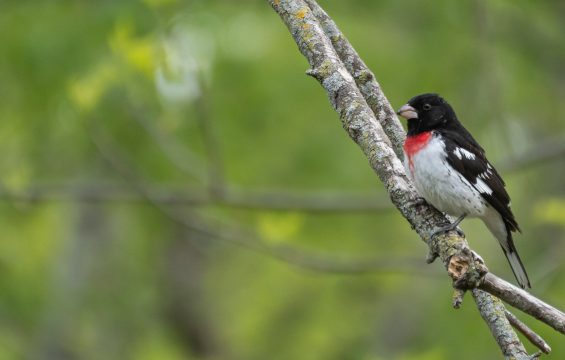Bird of the week: rose-breasted grosbeak
About: Males have a black head, back and wings with a white belly and wing patches and a red breast. Females have a dark brown back and light tan underside with darker spotting. Females also have a white eyebrow.
Where to find this bird: They tend to stay in the middle to upper canopy, where they eat primarily seeds. Any of the trees along the Fox River would be the best spot to find them around campus. They are a frequent feeder visitor.
When to find this bird: end of April through mid-October.
Fun fact: Both male and female rose-breasted grosbeaks sing songs and have been observed singing to each other when they switch incubating eggs.

Birding spots around Appleton
With migration in full swing and birds starting to stake out their breeding territories, birding in this part of Wisconsin is at its best. This time of year, I always make an effort to get a bit further out of town, usually on my bike. I thought I would share three of my favorite birding spots that are just a little further afield in case you, too, want to get out of Appleton for some birding.
High Cliff State Park
About an hour bike ride from campus and 20 minutes by car, High Cliff State Park offers some of the best birding in the Appleton area this time of year. It’s a popular place to hike and explore the outdoors and gets a lot of traffic, but the birdiest spots are a bit hidden. To your right when you first enter the park is the Butterfly Pond. This is an excellent spot to see migrant songbirds, and you can spot green- and black-crowned night herons hunting for fish along the pond, as well as multiple duck species. There is also a very large purple martin colony on the west side of the pond. The part that I find even more exciting is the prairie, which is situated just east of the campground and features many prairie specialities like bobolinks, dickcissels, orchard orioles, and Henslow’s sparrows. The best access point is the horse/bike trail parking lot just past the group campground. The forests of High Cliff are less birdy in my experience, but they are good spots to locate forest specialists such as scarlet tanagers and eastern wood-pewees.
LaSage Bottoms State Wildlife Area
Just east of Stephensville, Wis., this spot is about a 30-minute drive from campus and is a great spot for low boggy woodland specialists, including prothonotary warblers and wood thrushes, and is one of the best spots to find red-shouldered hawks in the area. I find most birds walking the service road (closed to vehicles) found just to the east of the Highway S bridge over the Wolf River. There is parking just west of the service road, which is also right by a prairie where I’ve found bobolinks and a few other prairie birds. This is a great spot for birds, but it also features swarms of mosquitoes, so be prepared!
Mack State Wildlife Area
As the best birding spot in the county with much habitat and bird diversity, this spot is a must visit for birders. It’s just west of Shiocton, Wis. and also about a 30-minute drive from campus. The Bergstrom Waterfowl complex, on the west side of Highway 54, features many ducks, rails, terns and migrating shorebirds. It features some unique breeders, including trumpeter swans, least bitterns, yellow-headed blackbirds and common gallinules. Birding is primarily restricted to along the road (not very busy) and an observation tower. There are some paths along the dikes, but these get overgrown quickly. Mack State Wildlife Area’s south side section is a mixture of marsh, forest and brushy fields and is a great place for warblers, cuckoos and other forest birds. The Newton Blackmour State Trail runs through this section of Mack and is a wonderful place to walk or bike in search of birds. Mack always holds surprises and is one of the most biodiverse spots in Outagamie county, with a bird list of over 230 species!
I’m super excited to be checking out these spots this spring in search of some exciting birds, and I hope you can check out the bird diversity in our area, too.
